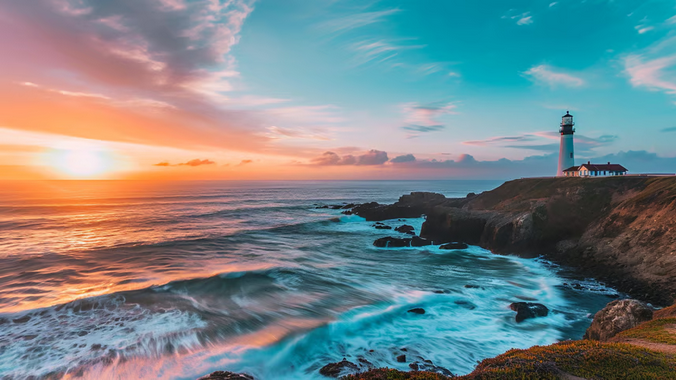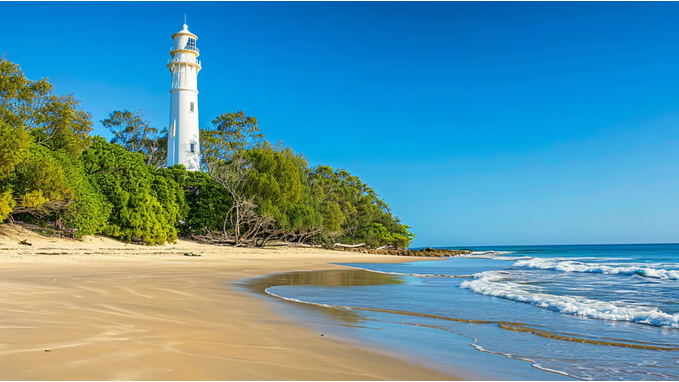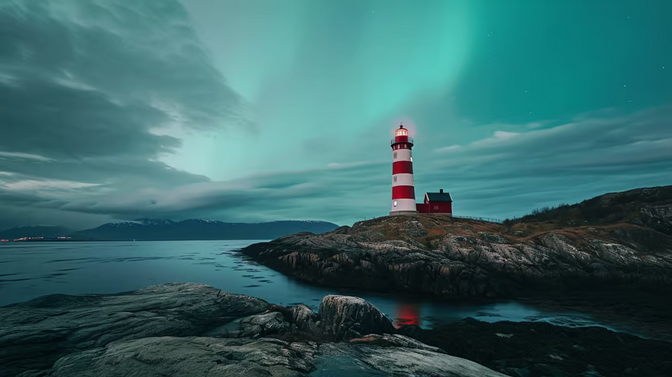Majestic Maritime Marvels: Lighthouses Guarding the World’s Most Beautiful Coasts
Journey to the world's most stunning coastlines, where majestic lighthouses stand as silent sentinels, their history and beauty guarding the meeting of land and sea with timeless grace and poise.12/6/20238 min read

Ever since humans first ventured into the vast expanse of the ocean, lighthouses have stood as steadfast guardians, offering a guiding light to mariners and protecting the coasts they adorn. These majestic structures have played a crucial role in maritime history, showcasing the courage and ingenuity of those who built and manned them. Let us delve into the captivating world of lighthouses and explore their historical significance, aesthetic appeal, and their future in the modern era.
The Historical Significance of Lighthouses
Throughout civilizations, lighthouses have held a place of reverence. These beacons of light have stood as symbols of hope and safety, guiding sailors home through treacherous waters. From the legendary Pharos of Alexandria in ancient Egypt to the iconic Eddystone Lighthouse in England, these structures have witnessed the rise and fall of empires, surviving the ravages of time.
Lighthouses have a rich and storied history, deeply intertwined with the maritime heritage of nations around the world. They have been witnesses to countless tales of bravery, tragedy, and triumph. Imagine the scene: a stormy night, waves crashing against the rocky shore, and a lone lighthouse keeper, diligently tending to the beacon that would save lives. These keepers were the unsung heroes of the sea, their dedication and vigilance ensuring the safe passage of countless ships.
The Evolution of Lighthouse Design
As navigation technology advanced, lighthouses too underwent a transformation, adapting to the changing needs of seafarers. From the rudimentary fires lit atop hills to the intricate Fresnel lens systems, lighthouse design evolved to maximize visibility and range. The development of these technological marvels revolutionized maritime safety, allowing ships to navigate with greater precision and reducing the risk of shipwrecks.
One of the most significant advancements in lighthouse design was the invention of the Fresnel lens by French physicist Augustin-Jean Fresnel in the early 19th century. This revolutionary lens system, consisting of a series of concentric prisms, greatly amplified the light emitted by the lighthouse, making it visible from greater distances. The Fresnel lens became the gold standard in lighthouse optics, and its design was adopted by lighthouses worldwide.
Lighthouses as Navigational Aids
In addition to illuminating the way, lighthouses have served as vital navigational aids. Mariners, both experienced and novice, have relied upon the distinct characteristics of each lighthouse's light pattern, such as its color, number of flashes, and duration, to identify their location and avoid peril. These lighthouses have not only guided ships but also woven themselves into the fabric of local maritime traditions.
Each lighthouse has its own unique personality, with its light pattern acting as a signature that mariners come to recognize and trust. For example, the Cape Hatteras Lighthouse in North Carolina, known for its distinctive black and white spiral stripes, has become an iconic symbol of the Outer Banks region. Similarly, the Cape Point Lighthouse in South Africa, perched on the edge of the continent, has guided countless ships along the treacherous Cape of Good Hope.
Over the centuries, lighthouses have become more than just functional structures; they have become beloved landmarks and symbols of coastal communities. They have inspired artists, writers, and poets, who have captured their beauty and significance in various forms of art. Lighthouses have also become popular tourist attractions, drawing visitors from far and wide who are captivated by their charm and historical allure.
Today, lighthouses continue to play a vital role in maritime navigation, albeit with modern advancements such as automated systems and GPS. However, their historical significance and enduring legacy cannot be understated. These beacons of light stand as a testament to human ingenuity, resilience, and the indomitable spirit of those who have dedicated their lives to keeping the seas safe.

The Aesthetic Appeal of Lighthouses
While lighthouses excel in their practical purpose, they also possess an undeniable allure. Their graceful architectural styles and strategic placement on rugged coastlines contribute to their magnetic charm.
But what exactly makes lighthouses so visually appealing? Let's explore the architectural styles and natural surroundings that make these structures truly captivating.
Architectural Styles of Lighthouses
From the elegant Victorian designs dotting the British coast to the stark simplicity of Scandinavian lighthouses, each structure boasts a unique architectural style. These architectural marvels are not only functional but also visually stunning, leaving a lasting impression on all who behold them.
Consider the whimsical charm of Cape Hatteras Lighthouse in North Carolina, USA. Standing at 210 feet, it is the tallest brick lighthouse in the United States and features a distinctive black and white spiral pattern. This iconic design has become synonymous with the Outer Banks region and has been a beacon of hope for sailors navigating the treacherous waters of the Atlantic Ocean.
On the other side of the world, the enchanting beauty of the La Jument Lighthouse in Brittany, France, captures the imagination with its dramatic location on a rocky outcrop. This iconic structure has been immortalized in photographs and paintings, symbolizing the resilience and strength of those who work tirelessly to keep the seas safe.
Whether it's the intricate detailing of a Victorian lighthouse or the minimalist elegance of a Scandinavian design, these architectural gems have captivated people for centuries, transcending their practical purpose to become symbols of beauty and inspiration.
Lighthouses and Their Natural Surroundings
Lighthouses often find themselves perched on the edge of rugged cliffs or ensconced amidst stunning natural landscapes. These strategic locations not only serve their practical purpose but also enhance the beauty of their surroundings, creating breathtaking vistas that leave visitors in awe.
Imagine standing at the top of Fanad Head Lighthouse, overlooking the pristine beaches of County Donegal, Ireland. The rugged cliffs, crashing waves, and endless stretches of golden sand create a scene straight out of a postcard. The lighthouse, with its white-washed walls and vibrant red trim, stands as a sentinel, harmoniously blending with the natural beauty that surrounds it.
Similarly, the picturesque spectacle of Cape Byron Lighthouse in New South Wales, Australia, framed by breathtaking ocean vistas, is a sight to behold. Perched on Australia's most easterly point, this iconic lighthouse offers panoramic views of the Pacific Ocean, with humpback whales often spotted during their annual migration. The combination of the lighthouse's striking white tower against the azure blue waters creates an image of tranquility and serenity.
These lighthouses not only guide ships safely through treacherous waters but also serve as beacons of beauty, drawing visitors from far and wide to witness the harmonious marriage of architecture and nature.
Lighthouses on the World's Most Beautiful Coasts
When it comes to the world's most beautiful coasts, lighthouses hold a revered place, their illumination blending seamlessly with nature's majesty. From the sun-kissed shores of the Mediterranean to the wind-swept cliffs of Scotland, let us embark on a journey to explore the enchanting lighthouses that grace these breathtaking coastlines.
Lighthouses of the Mediterranean
The Mediterranean, with its azure waters and sun-drenched beaches, boasts a collection of lighthouses that beckon weary sailors. One such lighthouse is the Cap de Formentor Lighthouse in Mallorca, Spain. Perched on a rocky cliff, it offers a panoramic view of the sparkling Mediterranean Sea. As the sun sets, the lighthouse casts a warm glow, creating a mesmerizing sight for those fortunate enough to witness it.
Another lighthouse that adds allure to the Mediterranean landscape is the Tower of Hercules in La Coruña, Galicia, Spain. This ancient Roman lighthouse stands tall as a testament to the region's rich history. With its commanding presence and architectural magnificence, it serves as a symbol of strength and guidance for sailors navigating the treacherous waters of the Mediterranean.
Guardians of the Pacific: Lighthouses on the U.S. West Coast
Stretching along the rugged west coast of the United States, a series of lighthouses silently stand sentinel over the mighty Pacific Ocean. One such iconic lighthouse is the Point Reyes Lighthouse in California. Perched on a cliff edge, it offers a dramatic view of crashing waves and rocky shores. The haunting sound of the foghorn resonates through the mist, serving as a warning to passing ships and adding an air of mystery to the surrounding landscape.
Further up the coast lies the towering Yaquina Head Lighthouse in Oregon. With its distinctive striped design and commanding height, it stands as a beacon of hope for sailors navigating the treacherous waters of the Pacific. The rugged cliffs surrounding the lighthouse provide a stark contrast to the vastness of the ocean, creating a scene of awe-inspiring beauty.
Lighthouses Adorning the Rugged Coasts of Scotland
The rugged and unforgiving coasts of Scotland house some of the most captivating lighthouses in the world. One such lighthouse is the Ardnamurchan Lighthouse, nestled on the peninsula bearing the same name. Surrounded by wild and untamed beauty, it stands as a symbol of Scotland's indomitable spirit. The sweeping views of the Atlantic Ocean from the lighthouse's vantage point are nothing short of breathtaking.
Another striking lighthouse in Scotland is the Neist Point Lighthouse on the Isle of Skye. Perched on a cliff edge, it boasts a striking silhouette against the dramatic backdrop of the rugged coastline. As the waves crash against the rocks below, the lighthouse stands tall, guiding ships through the treacherous waters and serving as a reminder of the power and resilience of nature.

The Modern Role and Preservation of Lighthouses
Despite the advancements in navigational technology, lighthouses continue to serve a vital purpose in the modern era. As tourist attractions and navigational aids, these structures find themselves at the crossroads of history and innovation.
Lighthouses as Tourist Attractions
With their rich heritage and breathtaking locations, lighthouses have become popular tourist destinations, offering visitors a glimpse into maritime history. From climbing the spiraling staircase of the Cape Point Lighthouse in South Africa for panoramic views to exploring the maritime museum at the Kullen Lighthouse in Sweden, these beacons of light provide visitors with a unique experience, blending education and adventure.
The Role of Lighthouses in Modern Maritime Navigation
While GPS and electronic navigation systems dominate modern maritime navigation, lighthouses still play a vital role in safeguarding ships from calamity. During storms or GPS failures, these steadfast structures guide mariners safely to harbor, their beams piercing through the dark night sky, instilling a sense of comfort and security.
Conservation Efforts for Historic Lighthouses
Recognizing the historical and cultural significance of lighthouses, preservation efforts have been launched worldwide. Organizations such as the National Lighthouse Museum in Staten Island, New York, and The Lighthouse Society in Scotland tirelessly work towards safeguarding these architectural gems, ensuring their legacy endures for generations to come.
The Future of Lighthouses
As technology continues to advance, the role of lighthouses may evolve, but their significance and symbolism will only grow stronger.
Technological Innovations in Lighthouse Design
New inventions and advancements in lighting systems are revolutionizing the way lighthouses operate. LED lights, solar-powered systems, and sophisticated remote monitoring technologies are transforming these structures into beacons of sustainability and efficiency, ensuring a greener future for maritime navigation.
The Impact of Climate Change on Lighthouses
With rising sea levels and increasingly severe weather patterns, lighthouses face new challenges. Some iconic lighthouses, such as the Heceta Head Lighthouse in Oregon, now find themselves perilously close to eroding cliffs. The battle against the forces of nature continues, requiring innovative solutions and renewed preservation efforts.
Lighthouses as Symbols of Resilience and Hope
Beyond their practical function, lighthouses symbolize resilience, guiding mariners and coastal communities through the storms of life. As beacons of hope, lighthouses stand tall as reminders that even in our darkest moments, guiding lights are there to navigate us towards safer shores.
In Conclusion
As we explore the world of lighthouses, we are reminded of their undeniable allure and historical significance. These majestic maritime marvels not only guard the world's most beautiful coasts but also inspire us with their beauty and resilience. From their evolution in design to their modern role and future innovations, lighthouses remain beacons of fascination and hope. As we admire these architectural wonders, let us also remember the dedicated individuals who have safeguarded our shores for centuries. So, the next time you find yourself near a lighthouse, take a moment to appreciate the silent heroism and unwavering light that have shaped our maritime history.
Now, it's time to embark on your own journey, exploring the lighthouses of the world and experiencing the magic they hold. Whether you choose to visit the Mediterranean, the U.S. West Coast, or the rugged coasts of Scotland, these majestic structures will undoubtedly leave an indelible mark on your soul. Let the light of the lighthouses guide you as you uncover the hidden stories and the breathtaking vistas that grace our world's most beautiful coasts.